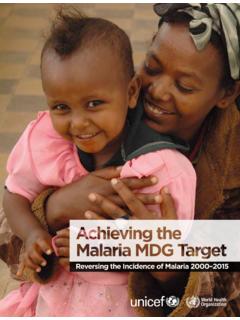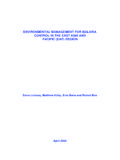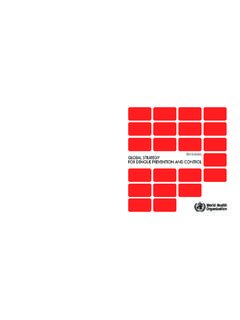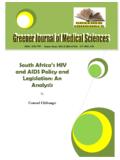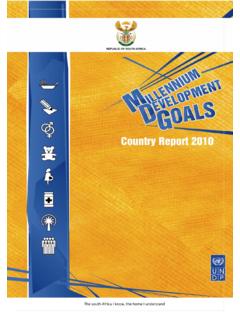Transcription of Partnership Strategy - World Health Organization
1 2010-20132010-2013 Partnership StrategyiPartnership Strategy2010 2013 World Health ORGANIZATIONR egional Office for AfricaBrazzaville 2009 Partnership StrategyPartnership Strategy2010 2013 Partnership Strategy 2010 - 2013 AFRO Library Cataloguing-in-Publication DataTitle Partnership Strategy 2010-20131. International Cooperation trends2. Public-Private Sector Partnerships trends3. Health resources Organization and administration4. International agenciesISBN: 978 929 023 1530 (NLM Classification: WA 530 HA1) WHO Regional Office for Africa, 2008 Publications of the World Health Organization enjoy copyright protection in accordance with the provisions of Protocol 2 of the Universal Copyright Convention. All rights reserved. Copies of this publication may be obtained from the Publication and Language Services Unit, WHO Regional Office for Africa, Box 6, Brazzaville, Republic of Congo (Tel: +47 241 39100; Fax: +47 241 39507; E-mail: Requests for permission to reproduce or translate this publication - whether for sale or for non-commercial distribution - should be sent to the same designations employed and the presentation of the material in this publication do not imply the expression of any opinion whatsoever on the part of the World Health Organization concerning the legal status of any country, territory, city or area or of its authorities, or concerning the delimitation of its frontiers or boundaries.)
2 Dotted lines on maps represent approximate border lines for which there may not yet be full mention of specific companies or of certain manufacturers products does not imply that they are endorsed or recommended by the World Health Organization in preference to others of a similar nature that are not mentioned. Errors and omissions excepted, the names of proprietary products are distinguished by initial capital reasonable precautions have been taken by the World Health Organization to verify the information contained in this publication. However, the published material is being distributed without warranty of any kind, either express or implied. The responsibility for the interpretation and use of the material lies with the reader. In no event shall the World Health Organization or its Regional Office for Africa be liable for damages arising from its in the Republic of MauritiusPartnership Strategy 2010 - 2013iiiContents PageExecutive Summary ivAbbreviations v1.
3 Introduction 12. Situation Analysis 2 Partnership mechanisms and characteristics 2 arrangements 43. Goal and Objectives 104. Guiding Principles 105. Strategic Approaches 11 Create an enabling environment for partnerships 11 Identify and engage in optimal partnerships 12 Promote Regional Office Partnerships 136. Critical Success Factor 147. Budget 148. Monitoring and Evaluation 15 Bibliography 16 AnnexesA: Organizations having signed MOUs with the Regional Office 19B: Survey 20C: List of Regional Office Partners 21D: Roles of the Civil Society 22E: PEPFAR Executing Partners 23F: WHO Partnerships 24 ivPartnership Strategy 2010 - 2013 Executive SummaryThe countries of WHO are no doubt disproportionately burdened by diseases and Health challenges. There is a real risk that the majority of countries in the Region will fail to meet the Millennium Development Goals.
4 There is a pressing case for a concerted effort that draws on the comparative strengths and advantages of all the major players in international public Health . WHO is in a unique position to manage, lead and facilitate partnerships for Health in Africa. The Regional Office plays a central role in establishing Health policies; providing technical guidelines and policy advice; setting norms and standards; contributing to sustainable capacity-building; strengthening management capacity; providing Health leadership; and coordinating efforts at the regional and national document presents an analysis of current trends and Regional Office institutional set up for engaging in more and improved partnerships to overcome challenges, achieve Health impacts and improve support to Member States in the Region. It suggests that emphasis should be placed on three actions: (i) developing an enabling environment for partnering, (ii) identifying and engaging in optimal partnerships and (iii) promoting partnerships for the Regional is the intention that the Regional Office, through a series of strategic approaches and activities, will forge new partnerships and expand existing ones that will generate more actions and outcomes to benefit the African Region and support country priorities.
5 Partnership Strategy 2010 - 2013vAbbreviationsAfDB African Development BankAFRO WHO Regional Office for AfricaAU African UnionCCS Country Cooperation StrategyCEMAC Monetary and Economic Community of Central AfricaCOMESA Common Market of Eastern and Southern AfricaCRHCS Commonwealth Regional Health Community SecretariatCSO Civil Society OrganizationEB Executive BoardECA Economic Commission for AfricaECOWAS Economic Community of West African StatesFTE Full Time EquivalentGAVI Global Alliance for Vaccines and ImmunizationGFATM Global Fund to Fight AIDS, Tuberculosis and MalariaHHA Harmonization for Health in AfricaHQ HeadquartersIHP+ International Health Partnership and Related InitiativesIMCI Integrated Management of Childhood IllnessIST Intercountry Support TeamJAS Joint Assistance StrategiesMDG Millennium Development GoalMOH Ministry of HealthMOU Memorandum of UnderstandingNEPAD New Partnership for Africa s DevelopmentNGO Nongovernmental OrganizationOCEAC Organization of Coordination for the Struggle Against Endemic Diseases in Central AfricaPEPFAR President s Emergency Plan for AIDS ReliefPRM Partnership and Resource Mobilization unitPUN Programme on Partnerships and UN ReformREC Regional Economic CommunityRM Resource MobilizationRMT Resource Mobilization TeamRO Regional OfficeviPartnership Strategy 2010 - 2013 SADC Southern African Development CommunitySO Strategic ObjectiveSOP Standard Operating ProcedureTB TuberculosisTOR Terms of ReferenceUEMOA West African Economic and
6 Monetary UnionUNDAF United Nations Development Assistance FrameworkUNGASS United Nations General Assembly Special Session on HIV/AIDSUNICEF United Nations Children s FundUSAID United States Agency for International DevelopmentVCT Voluntary Counselling and TestingWAHO West African Health OrganizationWB World BankWR WHO RepresentativePartnership Strategy 2010 - 201311. Introduction Two ants do not fail to pull one grasshopper African ProverbThis strategic plan was developed with cognizance of the tremendous Health challenges facing the African Region. It acknowledges that WHO needs strategic partners and partnerships to overcome them, to support the work of Member States and to advance WHO s global Health is WHO s second largest Region in terms of countries served (46). The challenges of the continent are numerous. The continent bears 66% of the global burden of AIDS and 60% of the global burden of malaria. The prevalence of TB is 492 cases per 100 000 inhabitants, the average maternal mortality ratio is 1000 per 100 000 live births, and infant mortality rate is about 57 per 1000 live births.
7 Adding low life expectancy at birth to the already high incidence of road accidents, cardiovascular diseases and anaemia to the already significant burdens represented by malaria, TB and HIV/AIDS, the continent carries one of the highest burdens of disease in the World . The Health challenges appear daunting and there is a real risk that the majority of countries in the Region will fail to meet the Millennium Development Goals (MDGs). Addressing and reversing the effects of the challenges cannot be accomplished by any single government or development agency. There is a pressing case for a concerted effort that draws on the comparative strengths and advantages of all the major players in the international development space. The WHO Regional Office for Africa, as the lead technical Health agency on the continent, is in a unique position to manage, lead and facilitate partnerships for Health in Africa. Already, the Regional Office plays a central role in establishing Health policies; providing technical guidelines and policy advice; setting norms and standards; contributing to sustainable capacity building; strengthening management capacity; providing Health leadership; and coordinating efforts at global, regional and national levels.
8 However, WHO is not a funding agency, nor does it have all the human and financial resources required to provide the technical support and input required by Member States. It recognizes the importance of partnering and creating synergies with other organizations to reach common goals and objectives and support countries in scaling-up and implementing required Health s global leadership in Health is also undisputed when it comes to global Health partnerships, and it is imperative that the Regional Office assume the role of facilitator and honest broker as well as participate in partnerships that will help further the international Health agenda, while assisting countries in the Region to succeed. This document presents a comprehensive Partnership Strategy for the WHO Regional Office for Africa, based on an analysis of the current trends and institutional set up for partnerships. The aim of the Strategy is to forge new and expand existing partnerships that will generate more action and outcomes in support of country priorities.
9 A resource mobilization Strategy complements this Strategy 2010 - 20132. Situation AnalysisThis section includes two types of analysis: an external analysis of relevant Health partnerships, including challenges and opportunities; and an internal analysis of WHO s policies, practices and enabling environment for partnerships. The term Partnership has recently become very fashionable and is used broadly to describe a wide variety of relationships and affiliations. It is also often and misleadingly used to describe a variety of relationships such as sponsor or donor relationships and the traditional exchange of goods or services for money. In the context of this Strategy , a much narrower definition of the term Partnership is used, and it describes the relationship between individuals or groups that is characterized by mutual cooperation and responsibility towards the achievement of a specified goal that relates to Partnership mechanisms and characteristics Partnership mechanismsThere are many Partnership mechanisms at the global, regional and country levels.
10 However, in this Strategy , few of them are mentioned as Reform. Since the late 1990s, the United Nations System started implementing an overarching reform in order to work better together and deliver more effectively at country level. The UN Reform is important for Partnerships as it addresses directly the ongoing fragmentation of aid to development and effectiveness in delivering results. The ultimate goal of the UN Reform is the change One UN to Delivering as One . In this context, eight pilot countries were According to the United Nations General Assembly Resolution,3 the Triennial Comprehensive Policy Review (TCPR) was adopted to guide operational activities of the UN System at country level, in the light of which the United Nations Development Assistance Framework (UNDAF) should be the basis for aligning the UN response to national priorities and national planning cycles. WHO is part of UN Reform through Resolution ,4 which requests the Director-General to adhere to the international alignment and harmonization Declaration5 and Accra Agenda for Action (AAA)6.


